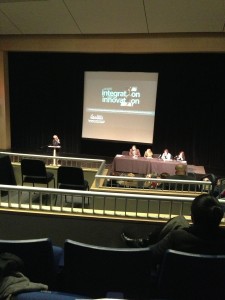“On Behalf of All Our Children”: The 1996 Appeal of Sheff v. O’Neill
The landmark court case charged with creating quality and integrated schooling in the Hartford area has been a labor of love on behalf of many and a long drawn out battle between citizens and the state of Connecticut. Stunned by the inequities between her son’s Hartford public school resources and that of their suburban neighbors, Elizabeth Horton Sheff filed a 1989 lawsuit against the city of Hartford that would put her family on the nation’s stage. In a 2011 interview, the outspoken Sheff reveals that the landmark case she spearheaded was never a “personal thing” for her. “It was always something that I engaged in on behalf of all our children,” Sheff says. A victory on paper that has been difficult to put into practice is what was won on behalf of Harford’s children in the 1996 Supreme Court ruling.
The Beginning of Sheff v. O’Neill
In 1989, Elizabeth Horton Sheff alongside several other parents from the city of Hartford and surrounding suburbs took the state to task over their children’s education. The 18 school children, with their parents at the forefront, presented the state of Connecticut with what would become a landmark lawsuit. In the suit, the families claimed that the state has contributed to the racial, ethnic, and economic isolation of Hartford students that led to subpar quality schooling in comparison to their suburban counterparts.
The Sheff case was eventually went to trial in 1992. After nearly three months of trial, Superior Court Judge Harry Hammer rules in favor of the state. He contended that state officials could not be held liable for rectifying educational inequalities, because the plaintiffs were not able to prove intent. He also asserted that the plaintiffs presented no proof that government action created the racial isolation that was so detrimental to the education of Hartford public school students.
The Sheff case eventually went to trial in 1992. After nearly three months, Superior Court Judge Harry Hammer rules in favor of the state. He contended that state officials could not be held liable for rectifying educational inequalities. He also asserted that the plaintiffs presented no proof that government action created the racial isolation that was so detrimental to the education of Hartford public school students.
Appeal and Victory: The 1996 Majority Opinion
After their 1995 loss, Sheff plaintiffs appealed their case to the State Supreme Court. It took the Justices ten months of deliberation to overturn Judge Hammer’s ruling and come back with a ruling in favor of the plaintiffs. The majority opinion, led by Justice Ellen Ash Peters, ruled that the state was in fact responsible for providing equal educational opportunities for all children. Section 42 of the 1996 ruling states:
“Despite the initiatives undertaken by the defendants to alleviate the severe racial and ethnic disparities among school districts, and despite the fact that the defendants did not intend to create or maintain these disparities, the disparities that continue to burden the education of the plaintiffs infringe upon their fundamental state constitutional right to a substantially equal educational opportunity.”
The dissenting opinion agreed that Hartford school children were at an educational disadvantage, but not solely because of racial isolation. The dissent named poverty, not merely racial isolation for the disadvantages the city’s students faced. The Connecticut Supreme Court disagreed. In this instance, the outcomes and not the intentions of the defendants’ actions had been tried. It was presumed that the state had not intended for the racial, economic, and ethnic isolation of Hartford school children, but they were charged with remedying it. The ruling also pointed to location of Greater Hartford urban-suburban school district boundary lines as a cause of racial isolation and deemed them unconstitutional. Despite the ruling’s progressive rhetoric, the court made no clear recommendations to create a racially, ethnically, and economically integrated city-suburban school system. The majority cried urgency for Hartford school children, yet “stayed their hand.” The Sheff plaintiffs had won, but what had they really accomplished on behalf of all our children?
To read more about Sheff v. O’Neill click here.
Sources
Eaton, Susan E. The Children in Room E4: American Education on Trial. Chapel Hill, NC: Algonquin of Chapel Hill, 2007. Print.
Sheff, Elizabeth Horton. Oral history interview on Sheff v. O’Neill (with video) by Candace Simpson for the Cities, Suburbs, and Schools Project, July 28, 2011. Available from the Trinity College Digital Repository, Hartford Connecticut.
“Sheff vs. O’Neill: A Timeline.” Courant.com. N.p., n.d. Web. 06 Oct. 2013. <http://www.courant.com/news/education/hc-sheff-oneill-timeline-flash,0,105112.flash>.
Sheff v. O’NEILL, 238 Conn. 1, 678 A.2d 1267 (1996).



